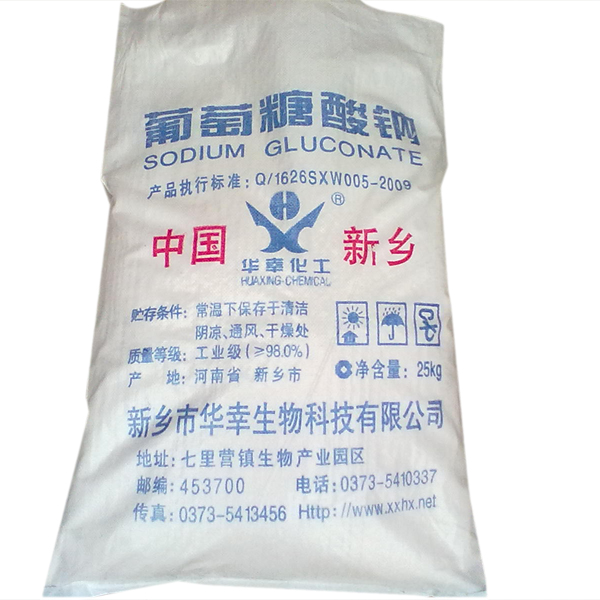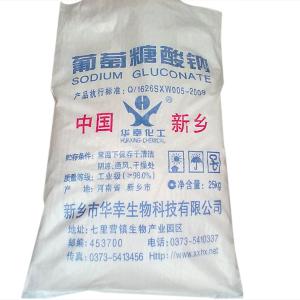
【产品类别】:Gluconate
【产品简述】:Product name: Sodium gluconateEnglish name: solid glucoseMol...
【服务范围】:公司专业从事磷化工产品、有机精细化学品的生产和经营。主要产品有:磷酸、沙坦联苯、三聚磷酸钠、六偏磷酸钠、焦磷酸钠、三聚磷酸钾、焦磷酸钾、正磷酸钾盐、钠盐、铝盐系列、葡萄糖酸钠、柠檬酸、柠檬酸盐、金属清洗剂系列等,部分产品有工业级和食品级2个规格。
13937338913
- The last one: No;
- The next one: No, no;
Product name: Sodium gluconate
English name: solid glucose
Molecular formula: C6H11NaO7
Molecular weight: 218.14
Packaging: 25KG
Origin: Xinxiang, Henan
Supply location: Xinxiang, Henan
CAS NO.: 527-07-1
Product specifications: FAO/WHO
Sodium gluconate
Basic properties of sodium gluconate:
Sodium gluconate, also known as pentahydroxyhexanoate, is a type of polyhydroxycarboxylate sodium with the molecular formula C6H11O7Na. It is a white crystalline particle or powder. Extremely soluble in water, slightly soluble in semen, insoluble in ether. Sodium gluconate is mainly used as an acid-base balancing agent, water quality stabilizer, surface cleaning agent, cement admixture, etc., and has a wide range of uses.
Appearance: White or light yellow crystalline powder, highly soluble in water, slightly soluble in semen, insoluble in ether, with a salty taste. Specifications: Compliant with the FAO/WHO standards of the United Nations Food and Agriculture Organization; USPXX III version; Enterprise standards; Customer requirements. Packaging: 25kg inner plastic outer woven bag; Customer requirements
Usage: acid-base balancing agent, water quality stabilizer, surface cleaning agent, cement admixture.
1、 Used as an acid-base balancing agent in medicine: to regulate the acid-base balance in the human body and restore normal nerve function. Sodium plays an important role in maintaining extracellular osmotic pressure and volume, regulating acid-base balance, and promoting normal neuromuscular function. This product can effectively prevent the occurrence of low sodium syndrome. Used for the same purpose as food additives;
2、 Used as a water quality stabilizer: Due to its corrosion and scale inhibition properties, sodium gluconate is widely used as a water quality stabilizer. Due to its corrosion and scale inhibition properties, sodium gluconate is widely used as a water quality stabilizer, such as as as a treatment agent for circulating cooling water systems in petrochemical enterprises, low-pressure boilers, and internal combustion engine cooling water systems. Because it has the following * * characteristics: ⑴ It has a clear coordination effect. Suitable for formulas such as molybdenum, silicon, phosphorus, tungsten, nitrite, etc. Due to the coordination effect, the corrosion inhibition effect is greatly improved The corrosion inhibition rate increases with increasing temperature. The corrosion inhibition rate of general corrosion inhibitors decreases with the increase of temperature, and even completely loses its effect. But sodium gluconate is the opposite, and the corrosion inhibition rate increases with temperature within a certain range. For example, in experiments on materials such as carbon steel, when the temperature rises from 77 ° C F to 120 ° C F, the average buffering rate increases by more than 5%. Therefore, the peculiar property of sodium gluconate is ideal for use as a corrosion inhibitor in systems with higher temperatures and in systems with variable temperatures from low to high Strong scale inhibition ability: It has strong chelating ability to calcium, magnesium, and iron salts, so its scale inhibition ability is very strong, especially for Fe3+chelation, even within the entire pH range Eliminate public hazards. The use of sodium gluconate as a corrosion and scale inhibitor for circulating cooling water can achieve environmental pollution control, which is an advantage that other corrosion and scale inhibitors currently used cannot compare with
3、 Used as a surface cleaning agent for steel: If the steel surface needs to be plated with a bowl, chrome, tin, or nickel to adapt to special purposes, such as manufacturing tinplate, galvanized sheet, or surface chrome plating (electronegativity), the surface of the steel billet needs to be strictly cleaned to ensure that the coating is firmly bonded to the steel surface. At this time, adding sodium gluconate to the cleaning agent will achieve a very ideal effect. This has been confirmed by large companies that manufacture tinplate internationally.
4、 As a cement admixture: Adding a certain amount of sodium gluconate to cement can increase the plasticity and strength of concrete, and has a blocking effect, delaying the initial and final setting periods of concrete. Therefore, sodium gluconate has been widely used as a cement admixture in important construction projects abroad, such as a large number of bridge construction projects in the Middle East.
After adding a certain amount of sodium gluconate to cement, the plasticity and strength of concrete can be increased, and it has a blocking effect, which delays the initial and final setting periods of concrete. For example, adding 0.15% sodium gluconate can extend the initial setting time of concrete by more than 10 times, which means extending the plasticity time of concrete from a few hours to a few days without affecting its fastness. Plasticity and delayed initial setting time are very important issues in concrete operations. For example, in construction during high temperature seasons and large-scale engineering operations, delaying the initial setting time is a difficult problem. Sodium gluconate can successfully solve this problem. In addition, it is quite difficult to bond oil wells at high temperatures. The concrete added with sodium gluconate can be plastic within a few hours at a high temperature of 170 ℃, thus successfully solving the above problems. Therefore, sodium gluconate as a cement admixture has been widely used in important construction projects abroad, such as in a large number of bridge projects in the Middle East. However, our domestic application in this area has not yet been promoted and applied. It is said that sodium cellulose sulfonate has been extracted from papermaking wastewater, and its effect is incomparable to that of sodium gluconate.
Sodium gluconate as a concrete admixture has the following advantages:
By using sodium gluconate, the W/C ratio can be reduced, which can increase the strength of concrete. This is a type of * * concrete.
Large and heavy pouring projects are difficult to construct. Due to the addition of sodium gluconate, the improvement of concrete workability and the delay of setting time can avoid the formation of interface on the structure, resulting in an increase in structural strength.
Maintaining a constant W/C ratio in hot areas is of great significance in enhancing work efficiency. A large amount of sodium gluconate was used in the construction of bridges in the Middle East.
Adding sodium gluconate to concrete mix can delay the setting time, which is important for long-term and difficult pouring.
In modern concrete industry, ready mixed concrete is prepared at a central location and then transported by mixer trucks. In this case, increasing workability and initial solidification time are crucial.
Reducing the W/C ratio can produce concrete with higher strength and durability, and sodium gluconate can achieve this goal. This is very important for reinforced concrete of * * degree.
The precast masonry mortar must be usable for a long period of time. Adding sodium gluconate can prolong the working period.
Due to the high temperature, it is difficult to operate the oil well water slurry. After adding sodium gluconate, the concrete can work for several hours at a temperature of 170 ℃.
5: Used as a special cleaning agent for glass bottles: Glass bottles mainly formulated with sodium gluconate can improve the following common problems: weak descaling ability, easy blockage of the nozzle and pipeline of the bottle washing machine; The ability to remove rust from bottle stickers and bottlenecks is not ideal; The trace residue after washing is not ideal for food safety (such as phosphate residue); Washing water discharge becomes a public hazard (cannot meet the standards specified in * * regulations).
Quality indicators of sodium gluconate:
Project FAO/WHO US Pharmacopoeia Standard USP XXIII Edition Enterprise Standard
Appearance: White to light yellow crystalline particles, white to light yellow crystalline particles, white to light yellow crystalline particles
Content ≥ 98% ≥ 98% ≥ 98.5%
Chloride - ≤ 0.07% ≤ 0.05%
Arsenic salt ≤ 3P P. M ≤ 3P P. M ≤ 3P P. M
Lead salt ≤ 10P P. M ≤ 10P P. M ≤ 0.001%
Heavy metals ≤ 20P P. M ≤ 20P P. M ≤ 0.002%
Sulfate - ≤ 0.05% ≤ 0.05%
Reduced substances ≤ 0.5% ≤ 0.5% ≤ 0.5%
Synthesis method:
In industry, substances containing glucose (such as grains) are generally used as raw materials. Gluconic acid is first produced from glucose by fermentation, and then neutralized by sodium hydroxide to obtain sodium gluconate. Electrolysis and oxidation synthesis can also be used. In China, chemical oxidation and hypobromoxidation methods are mostly used for production and synthesis According to the different types of fermentation enzymes used, the fermentation method can be divided into two steps: one is using Aspergillus Niger's enzyme, and the other is acid. The latter method uses glucose dehydrogenation to form lactones, which are then broken down Sodium gluconate can also be directly fermented from glucose. At this time, the composition of the fermentation substrate can be: glucose 250-350G/L, magnesium sulfate heptahydrate 0.2-0.3G/L, diammonium hydrogen phosphate or urea 0.4-0.5g/l. This substrate needs to be sterilized. During the fermentation process, the temperature is controlled at 30-32 degrees Celsius, and the pH is controlled at 5.5-6.5 using 30% -50% sodium hydroxide. The fermentation process lasts for 40-100H. Then, microorganisms are removed by filtration and washing, and activated carbon is used for decolorization, followed by filtration, Concentrate the result or spray dry the finished product
Safety, Health and Protection
Sodium gluconate is non-toxic. Sodium gluconate and its chelates with heavy metal ions present in water can be rapidly and completely degraded through conventional biochemical treatment. The heavy metal ions released during the degradation process can be removed by precipitation or adsorbed on the sludge formed during the wastewater treatment process.
 Chinese
Chinese  English
English 

